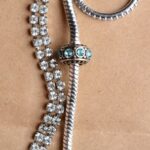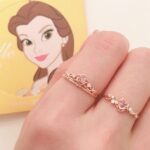What is the difference between high jewelry and fine jewelry? These terms are often used interchangeably, but they actually represent distinct categories within the jewelry industry. In this article, we will delve into the defining characteristics of high jewelry and fine jewelry, as well as explore their unique features, materials, craftsmanship, design elements, pricing, historical significance, market trends, and consumer demand.
Fine jewelry represents a category of luxury items that are crafted with exquisite attention to detail and precision. It typically features precious metals such as gold or platinum, adorned with high-quality gemstones such as diamonds, rubies, sapphires, and emeralds. On the other hand, high jewelry represents the epitome of sophistication and exclusivity in the world of luxury adornments. It encompasses rare and exceptional pieces that are meticulously crafted by master artisans using the finest quality gemstones and precious metals.
When it comes to differentiating high jewelry from fine jewelry, it all boils down to the level of craftsmanship and materials used. The distinction becomes apparent in the design elements, aesthetic appeal, pricing structures, historical significance, market demands, and overall value that these categories offer to consumers. Throughout this article, we will unpack these differences and gain a deeper understanding of how high jewelry and fine jewelry have shaped the landscape of the jewelry industry.
Definition of Fine Jewelry
Fine jewelry is a category of jewelry that is crafted with high-quality materials such as precious metals like gold, silver, and platinum. It also includes gemstones such as diamonds, rubies, sapphires, and emeralds. Fine jewelry is typically made with a high level of craftsmanship and attention to detail, ensuring that each piece is of superior quality. The emphasis on quality and durability distinguishes fine jewelry from other categories, making it a popular choice for special occasions and everyday wear.
One of the key characteristics of fine jewelry is its timeless design and enduring value. Fine jewelry pieces are often classic and elegant, designed to be treasured for generations. Another defining feature of fine jewelry is its versatility – it can be worn casually or for formal events, adding a touch of sophistication to any outfit. Additionally, fine jewelry is often passed down as heirlooms due to its longevity and timeless appeal.
When it comes to the criteria for fine jewelry, there are industry standards that govern the use of precious metals and gemstones. For example, the purity levels of gold and silver used in fine jewelry are regulated to ensure authenticity and quality. Gemstones used in fine jewelry must meet specific criteria for color, clarity, cut, and carat weight to be classified as fine quality. These strict guidelines contribute to the overall value and desirability of fine jewelry in the market.
Overall, what sets fine jewelry apart from other categories is its emphasis on quality materials, superior craftsmanship, timeless design, enduring value, and adherence to industry standards for precious metals and gemstones. This distinction makes fine jewelry a sought-after choice for discerning consumers who appreciate both luxury and longevity in their accessories.
Definition of High Jewelry
Unique Features of High Jewelry
High jewelry is characterized by its exceptional quality and craftsmanship. Each piece is painstakingly crafted by expert artisans using the finest materials available. From rare gemstones to exquisite diamonds, high jewelry pieces are known for their unparalleled beauty and extravagance. These pieces often feature intricate designs, elaborate settings, and meticulous attention to detail.
Standards of High Jewelry
One of the defining features of high jewelry is its exclusivity. These pieces are often produced in very limited quantities, making them highly sought after by collectors and connoisseurs. The standards for high jewelry also extend to the ethical sourcing of materials and the responsible practices employed in production. High jewelry houses prioritize ethical and sustainable practices to ensure that their creations are not only beautiful but also ethically sound.
Distinguishing High Jewelry From Fine Jewelry
The main difference between high jewelry and fine jewelry lies in the quality, craftsmanship, and exclusivity. While fine jewelry is certainly luxurious and well-crafted, high jewelry sets itself apart with its unparalleled beauty, rarity, and meticulous attention to detail. Additionally, high jewelry often carries a higher price tag due to the exceptional quality of materials used and the limited availability of these pieces. These distinctions make high jewelry a coveted category within the world of luxury accessories.
Ultimately, what sets high jewelry apart is its exceptional quality, exquisite craftsmanship, exclusivity, and adherence to ethical standards. It embodies the pinnacle of artistry in the world of fine jewelry, commanding admiration from enthusiasts around the globe for its beauty and prestige.
Material and Craftsmanship
When it comes to the distinction between high jewelry and fine jewelry, one of the key differences lies in the materials used and the level of craftsmanship involved. Fine jewelry often refers to pieces that are crafted from precious metals such as gold, silver, and platinum, and may also feature gemstones like diamonds, rubies, sapphires, and emeralds. The emphasis on fine jewelry is on the quality of the materials used, with a focus on durability and timeless elegance.
On the other hand, high jewelry takes the use of materials and craftsmanship to a whole new level. High jewelry pieces are characterized by their use of exceptionally rare and valuable gemstones such as vivid colored diamonds, natural pearls, and unique sapphires. The craftsmanship involved in creating high jewelry is meticulous and intricate, often involving elaborate designs and complex settings that showcase the exceptional beauty of these rare gems.
To further illustrate the contrast between high jewelry and fine jewelry in terms of material and craftsmanship:
- Fine Jewelry:
- Materials: Gold, silver, platinum
- Gemstones: Diamonds (often smaller carat weights), rubies, emeralds
- Craftsmanship: Skilled artisans create elegant but simpler designs
- High Jewelry:
- Materials: Exceptionally rare gemstones (vivid colored diamonds, natural pearls)
- Craftsmanship: Master jewelers employ highly intricate techniques to create elaborate designs
Ultimately, while both high jewelry and fine jewelry exude luxury and quality in their own right, it is evident that their material choices and levels of craftsmanship set them apart in distinct ways.
Design and Aesthetics
When it comes to the design and aesthetics of jewelry, both high jewelry and fine jewelry showcase distinct characteristics that set them apart in the industry. Understanding these differences can provide valuable insight into the craftsmanship, creativity, and overall appeal of each type of jewelry.
Design Elements
Fine jewelry often focuses on timeless and classic designs that are meant to be worn every day. The emphasis is on simplicity, elegance, and versatility, with a focus on incorporating precious gemstones and metals into wearable pieces.
In contrast, high jewelry pushes the boundaries of creativity and innovation, featuring elaborate, one-of-a-kind designs that are often created as art pieces rather than everyday accessories. High jewelry designs may incorporate rare and unique gemstones, intricate detailing, and dramatic statement pieces.
Aesthetic Differences
The aesthetic differences between high jewelry and fine jewelry are striking. Fine jewelry typically exudes a sense of understated luxury, with its refined elegance and subtle sophistication. These pieces are designed to complement an individual’s personal style without overpowering it. On the other hand, high jewelry makes a bold statement with its opulence and extravagance. The aesthetic of high jewelry is often more flamboyant, grandiose, and theatrical, featuring larger-than-life designs that captivate attention.
Artistry and Craftsmanship
Artistry plays a crucial role in both high jewelry and fine jewelry, but the level of craftsmanship differs significantly between the two. Fine jewelry is meticulously crafted with precision to ensure durability and wearability. While it still requires skilled artisans to create these pieces, the emphasis is on practicality without compromising beauty.
In contrast, high jewelry demands exceptional artistry and skill to bring avant-garde concepts to life. The intricate details in high jewelry require unparalleled craftsmanship to execute complex designs with perfection.
Understanding the design elements and aesthetic differences between high jewelry and fine jewelry provides insight into their distinct appeal for different types of consumers. Whether one gravitates towards understated elegance or extravagant opulence ultimately determines which type of jewellery will resonate more strongly with them.
Price and Value
When it comes to understanding the difference between high jewelry and fine jewelry, one of the key factors that sets them apart is their pricing and value. Fine jewelry is typically crafted using precious metals such as gold, silver, or platinum, along with gemstones like diamonds, pearls, or colored stones. These pieces are more affordable compared to high jewelry and are often considered everyday luxury items.
On the other hand, high jewelry is associated with luxury brands and renowned designers, using the highest quality materials such as flawless diamonds, rare gemstones, and exquisite craftsmanship. As a result, high jewelry commands a much higher price point due to its exclusivity and exceptional quality.
The pricing of fine jewelry is influenced by the market value of the raw materials used in its creation, along with factors such as design complexity and brand reputation. While they are still considered luxury items, fine jewelry pieces are more accessible to a wider range of consumers due to their relatively lower price range compared to high jewelry.
In contrast, high jewelry is characterized by its exceptionally high prices which can often reach millions of dollars per piece. This is due to the superior quality of materials used and the intricate craftsmanship involved in creating these one-of-a-kind pieces.
In terms of value distinctions, both high jewelry and fine jewelry are considered valuable assets; however, their perceived value differs based on their exclusivity and rarity. Fine jewelry holds its value predominantly through the intrinsic worth of its materials such as gold or diamonds.
Conversely, high jewelry derives its value from its brand prestige, historical significance, limited availability, and exceptional craftsmanship. This distinction contributes to the perception that high jewelry is not just an accessory but also an investment in artistry and heritage.
| Category | Fine Jewelry | High Jewelry |
|---|---|---|
| Materials | Precious metals (gold, silver), gemstones (diamonds) | Highest quality materials (flawless diamonds), rare gemstones |
| Pricing | Relatively affordable for luxury items | Very expensive; can reach millions per piece |
| Value | Intrinsic worth of materials (gold/diamonds) | Brand prestige/historical significance/limited availability/craftsmanship |
History and Heritage
When it comes to understanding the difference between high jewelry and fine jewelry, exploring their history and heritage can provide valuable insights. Both high jewelry and fine jewelry have deep roots in tradition and craftsmanship, but their historical significance sets them apart in the world of luxury accessories.
Here are some key points to consider when exploring the history and heritage of high and fine jewelry:
- Historical origins: Fine jewelry has a long-standing tradition that dates back centuries, encompassing various cultures and civilizations. From ancient Egyptian adornments to Roman-inspired designs, fine jewelry has evolved over time to reflect different artistic movements and design influences.
- Royal connections: High jewelry often has strong ties to royalty and aristocracy, with prestigious houses creating elaborate pieces for coronations, weddings, and other significant events. These pieces carry a rich historical legacy, often passed down through generations as symbols of wealth and power.
- Heritage craftsmanship: Both high jewelry and fine jewelry are known for their exceptional craftsmanship, with many renowned ateliers preserving traditional techniques while embracing modern innovations. The heritage of these craftsmanship traditions adds a layer of prestige to each piece, making them highly sought after by collectors and connoisseurs.
By delving into the historical significance and heritage of high and fine jewelry, we can gain a deeper appreciation for the cultural impact of these luxurious accessories. Understanding their origins helps us recognize the enduring allure of both high-end masterpieces and finely crafted pieces in today’s global market.
Market and Demand
When it comes to the market trends and demand for jewelry, both high jewelry and fine jewelry play significant roles in shaping consumer preferences. However, the difference between high jewelry and fine jewelry can also be observed in their respective markets.
Fine jewelry is more mainstream, often found in retail stores and online shops that cater to a wider consumer base. On the other hand, high jewelry is characterized by its exclusivity and is typically available only through select upscale retailers or directly from high-end brands.
One of the main factors that contribute to the distinction in market trends between high jewelry and fine jewelry is the target audience. Fine jewelry is designed to appeal to a broad range of consumers with varying purchasing power, while high jewelry is targeted at an elite clientele who seek luxury, sophistication, and unique craftsmanship.
This has a direct impact on the marketing strategies employed by brands, as well as the distribution channels used to make these products accessible to their intended buyers.
In addition, market trends also reflect the demand for each type of jewelry. Fine jewelry tends to have a consistent demand throughout different economic cycles due to its accessibility and relatively affordable pricing compared to high-end luxury items.
High jewelry, on the other hand, may experience fluctuations in demand based on global economic conditions and shifts in consumer spending patterns. Despite this, there continues to be a steady demand for high jewelry among discerning buyers who value rarity, prestige, and investment value in their purchases.
| High Jewelry | Fine Jewelry |
|---|---|
| Exclusive distribution channels | Wider availability through retail stores and online shops |
| Targeted at elite clientele | Designed for a broad range of consumers |
| Demand influenced by global economic conditions | Consistent demand throughout different economic cycles |
Conclusion
In conclusion, the difference between high jewelry and fine jewelry lies in various aspects such as craftsmanship, materials used, design, historical significance, and market demand. Understanding these distinctions is essential for both industry professionals and consumers.
Fine jewelry is characterized by its use of precious metals and gemstones, often with a focus on timeless designs and everyday wear. On the other hand, high jewelry is known for its exceptional craftsmanship, exquisite gemstones, and unique, one-of-a-kind designs that are often reserved for special occasions.
One of the key differences between high jewelry and fine jewelry is the level of craftsmanship and the use of rare or exceptional gemstones. High jewelry pieces require highly skilled artisans to bring intricate designs to life using only the highest quality materials.
Fine jewelry also showcases expert craftsmanship but often in simpler, more accessible designs. The value of rarity and uniqueness adds to the allure of high jewelry, making it highly sought after by collectors and connoisseurs in the industry.
Another important distinction is the pricing and market demand for high versus fine jewelry. High jewelry commands significantly higher prices due to the exclusive nature of each piece and the unparalleled quality of gemstones. This exclusivity leads to a niche market segment with a limited customer base.
In contrast, fine jewelry caters to a broader consumer market looking for well-crafted pieces that offer both aesthetic appeal and lasting value at a more accessible price point. Ultimately, understanding these differences empowers consumers to make informed decisions when purchasing jewelry based on their preferences, budget, and occasion.
Frequently Asked Questions
What Is High Jewelry vs Fine Jewelry?
High jewelry is the crème de la crème of the jewelry world, often featuring rare and precious gemstones like diamonds, rubies, emeralds, and sapphires. It is typically designed and crafted by top-tier jewelry artisans using the highest quality materials and techniques. High jewelry pieces are known for their exceptional craftsmanship, unique designs, and significant value.
What Is Considered as Fine Jewelry?
Fine jewelry refers to jewelry pieces that are made with precious metals such as gold, platinum, or silver and may also include high-quality gemstones like diamonds, rubies, sapphires, and emeralds.
These pieces are often more accessible in terms of price compared to high jewelry but still maintain a level of craftsmanship and material quality that sets them apart from fashion or costume jewelry.
What Is Considered High Quality Jewelry?
High quality jewelry is characterized by several key factors including the use of genuine materials such as solid gold or platinum, natural gemstones with excellent clarity and color, expert craftsmanship that results in durable and well-made pieces, and attention to detail in design and finishing.
Whether it’s a simple pair of diamond stud earrings or an elaborate diamond necklace, high quality jewelry reflects superior standards in both materials and workmanship.

Welcome to my jewelry blog! My name is Sarah and I am the owner of this blog.
I love making jewelry and sharing my creations with others.
So whether you’re someone who loves wearing jewelry yourself or simply enjoys learning about it, be sure to check out my blog for insightful posts on everything related to this exciting topic!





